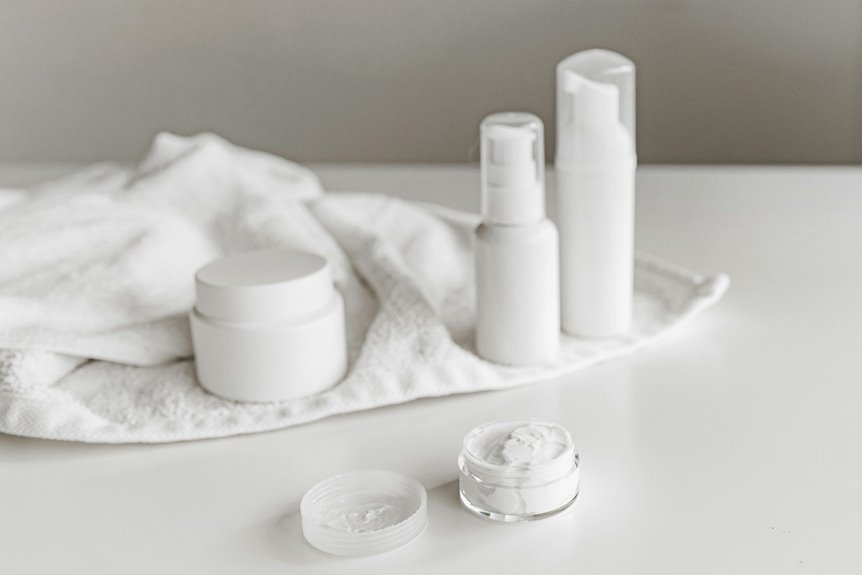When you're choosing between gel and foam wrist rests, consider their pros and cons. Gel wrist rests offer superior comfort and promote fluid movement, but they can retain heat and may wear out faster. Foam wrist rests are lightweight and portable but can compress over time and trap heat. Each option has its drawbacks, so think about your unique needs and preferences. Keep exploring to find the best choice for your typing or gaming comfort!
Table of Contents
Key Takeaways
- Gel wrist rests provide superior comfort and support but may retain heat, causing discomfort during extended use.
- Foam wrist rests are lightweight and portable, but can compress over time, losing shape and support.
- Gel options promote fluid hand movement and are easy to clean, while foam can trap heat and odors.
- Foam wrist rests are generally budget-friendly but may require more frequent replacement compared to gel.
- Consider personal comfort, maintenance, and long-term use when choosing between gel and foam wrist rests.
Overview of Gel Wrist Rests
Gel wrist rests are designed to provide comfort and support during long hours of typing or gaming. These accessories help maintain a neutral wrist position, reducing strain and fatigue.
Made from a soft, pliable gel material, they conform to your wrist's shape, offering a personalized fit. You'll find gel wrist rests come in various sizes and styles, making it easy to choose one that suits your workspace.
Their smooth surface allows for effortless movement of your hands, enhancing your overall experience. They're also often easier to clean than other materials.
When you invest in a gel wrist rest, you're prioritizing your comfort, which can lead to improved productivity and a more enjoyable time spent at your computer.
Advantages of Gel Wrist Rests
When you choose gel wrist rests, you're in for superior comfort that can make long hours at your desk more bearable.
Their enhanced support features help reduce strain on your wrists, allowing you to focus on your work.
Plus, cleaning them is a breeze, so you can keep your workspace tidy without hassle.
Superior Comfort Levels
While typing for extended periods, you might find that a gel wrist rest can significantly enhance your comfort levels. The softness of gel conforms to the shape of your wrists, providing a cushion that reduces pressure points. This adaptability can help prevent discomfort, allowing you to focus on your work instead of adjusting your hands.
Additionally, gel wrist rests tend to stay cooler than foam options, helping to minimize sweat and heat buildup during long sessions. You'll appreciate how this cooler feel contributes to an overall more pleasant typing experience.
With their smooth surface, gel wrist rests also allow for easy hand movement, promoting fluid motion without hindrance. In short, these features combine to create a more comfortable typing environment.
Enhanced Support Features
Enhanced support features in gel wrist rests can make a noticeable difference in your typing experience. The gel material molds to the shape of your wrists, providing a customized fit that encourages proper alignment. This helps reduce strain on your wrists and forearms during long hours of typing.
Unlike foam, gel maintains its shape, giving you consistent support without flattening over time. You'll appreciate the added stability it offers, preventing your wrists from sinking too low or being unsupported.
With gel wrist rests, you'll notice less fatigue and discomfort, allowing you to stay focused on your tasks. Investing in a gel wrist rest can significantly enhance your overall comfort and productivity while working at your computer.
Easy to Clean
One of the standout advantages of gel wrist rests is how easy they're to clean, making them a practical choice for anyone who spends long hours at a computer.
Unlike foam wrist rests, which can absorb moisture and dirt, gel surfaces are typically wipeable. You can simply use a damp cloth with mild soap to remove spills or grime.
This quick maintenance ensures a hygienic workspace, reducing the risk of germs accumulating over time. Plus, the non-porous nature of gel means you won't have to worry about odors or stains lingering.
Disadvantages of Gel Wrist Rests
While gel wrist rests offer comfort, they also come with some drawbacks.
You might find that they retain heat, making your wrists warmer during long sessions.
Additionally, concerns about their durability and weight can affect portability, which is something to consider if you're on the go.
Heat Retention Issues
Although gel wrist rests offer comfort during long hours of typing, they can pose significant heat retention issues. The gel material tends to trap heat, leading to discomfort as your wrists warm up. This can distract you from your work and may even cause sweating, which is less than ideal.
| Issue | Description | Impact |
|---|---|---|
| Heat Build-up | Gel retains heat, making it uncomfortable | Distraction |
| Sweating | Increased heat can lead to sweaty wrists | Reduced grip |
| Discomfort | Prolonged use may cause irritation | Decreased productivity |
| Fatigue | Constant heat can lead to fatigue | Lower focus |
Considering these factors, you might want to weigh your options when choosing a wrist rest.
Limited Durability Concerns
Gel wrist rests may offer initial comfort, but their limited durability can be a significant drawback. Over time, you might notice the gel breaking down or losing its shape due to consistent pressure and use. This deterioration can lead to discomfort as you type, negating the benefits you initially experienced.
Additionally, the outer material may wear out faster than you'd like, exposing the gel beneath and making it less hygienic. Unlike foam wrist rests, which can often withstand daily wear and tear better, gel options can show signs of wear in just a few months.
If you're investing in a wrist rest, consider how often you'll use it and whether durability is a priority for your comfort and support.
Weight and Portability Factors
When considering wrist rests, weight and portability can be significant drawbacks, especially with gel options. Gel wrist rests are often heavier, making them less convenient for travel or quick setups. If you're frequently on the go, lugging around a bulky gel wrist rest can feel cumbersome.
| Factor | Gel Wrist Rests | Foam Wrist Rests |
|---|---|---|
| Weight | Heavier | Lighter |
| Portability | Less portable | Highly portable |
| Travel-Friendly | Not ideal | Perfect for travel |
For daily commutes or working remotely, you might prefer the lightweight nature of foam wrist rests. Ultimately, if portability matters to you, gel options might not be the best fit.
Overview of Foam Wrist Rests
Foam wrist rests are popular accessories for anyone who spends long hours typing or using a mouse. They're designed to provide a cushioned surface that supports your wrists, helping to reduce strain during extended use.
Made from materials like memory foam or polyurethane, these rests conform to your wrist's shape, offering a comfortable fit. Foam wrist rests come in various sizes, shapes, and thicknesses, allowing you to choose one that suits your setup.
They're typically lightweight and easy to transport, making them a practical choice for both home and office environments. While they may not offer the same cooling properties as gel options, foam wrist rests are often appreciated for their affordability and variety.
Advantages of Foam Wrist Rests
Using foam wrist rests can significantly enhance your comfort during long hours of typing or mouse use.
They provide a soft, cushioned surface that supports your wrists, reducing strain and promoting better alignment. This can help prevent discomfort and fatigue, allowing you to work longer without feeling the need to take frequent breaks.
Foam wrist rests are also lightweight and portable, making them easy to move between workspaces. Additionally, they come in various sizes and designs, allowing you to find one that suits your personal style and needs.
Their affordability adds to their appeal, making them a budget-friendly option for anyone looking to improve their workstation ergonomics.
Disadvantages of Foam Wrist Rests
Although foam wrist rests can enhance comfort, they also come with several drawbacks that users should consider.
Here are some issues you might encounter:
- Durability: Foam can compress over time, losing its shape and support.
- Heat Retention: Foam tends to trap heat, which can make your wrists feel warm and sweaty during long sessions.
- Cleaning Challenges: Unlike gel options, foam isn't easy to wipe down and can absorb spills or odors.
- Limited Support: Depending on the foam density, you mightn't get enough support for your wrists, potentially leading to discomfort after extended use.
Understanding these disadvantages can help you make a more informed choice about your wrist rest needs.
Frequently Asked Questions
How Do I Clean Gel and Foam Wrist Rests?
To clean gel and foam wrist rests, use a damp cloth with mild soap. Wipe gently, then rinse with a clean, damp cloth. Let them air dry completely before using them again for optimal hygiene.
Can Wrist Rests Improve Typing Posture Significantly?
Yes, wrist rests can significantly improve your typing posture. They support your wrists, keeping them aligned and reducing strain. This helps prevent discomfort and encourages a more ergonomic position while you type, enhancing your overall productivity.
Are There Specific Brands Recommended for Gel or Foam Wrist Rests?
When choosing wrist rests, brands like HyperX, 3M, and Fellowes are often recommended. They offer quality options in both gel and foam, ensuring comfort and support for your typing needs. You'll find one that suits you!
What Is the Average Lifespan of Gel and Foam Wrist Rests?
The average lifespan of gel wrist rests is about two to three years, while foam ones typically last longer, around three to five years. Regular use and care can influence how long they'll last.
Are There Any Health Risks Associated With Using Wrist Rests?
Yes, using wrist rests can pose health risks. If your wrist is improperly supported or positioned, you might experience discomfort, strain, or even repetitive strain injuries. Make sure you adjust your setup to maintain proper ergonomics.




